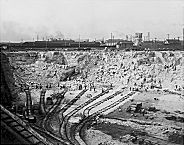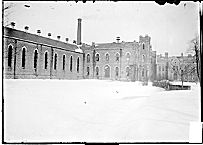| Entries |
| J |
|
Jails and Prisons
|

|
The House of Correction opened in 1871 on the city's far Southwest Side. This prison workhouse confined mainly individuals unable to pay fines: vagrants, drunks, petty thieves, pickpockets, counterfeiters, smugglers, and especially criminals preying on the growing commerce of Chicago's docks. Nearly all were poor; most had been imprisoned before. Moreover, it was common practice to imprison witnesses to crimes—often women and children—along with the accused against whom they were scheduled to testify.
During this period the police station-house lockup—the “calaboose”—emerged as Chicago's standard form of custody for street criminals. Overused and filthy dens of despair, these “police prisons” finally gave way, by the late 1890s, to the improved construction and architectural design of the city's correctional facilities. A new addition to the County Jail in 1896 at Dearborn Avenue and Illinois Street included separate facilities for women and a section for juvenile offenders.

|
Subject to the politics of a one-term sheriff and an entrenched patronage system, the County Jail had to rely on a grossly untrained and underpaid jail guard corps. As a result, the wardens and supervisors yielded to the convenience of a “barn boss” system using particularly intimidating inmates for guard functions. This system inadvertently fostered the growth of gang influence in the inmate population and jail operations. In 1967, a county civil service system was introduced to counter the political influence of patronage jobs and to better prepare officers to manage the jail. In 1974, the Illinois Department of Corrections opened the nation's first centralized training academy for correctional officers at Saint Xavier University in Mount Greenwood.

|
Now officially defined and readily recognized by the public and media as the Cook County Department of Corrections, it boasts “the largest (96 acres) single-site county pre-detention facility in the United States.” It has 11 jail divisions, as well as a boot camp, an electric monitoring program for community correctional custody, a halfway house, and a substance-abuse program. It also contains the largest forensic residential psychiatric facility in Illinois and is developing gender-specific programs for female and male inmates.
The Encyclopedia of Chicago © 2004 The Newberry Library. All Rights Reserved. Portions are copyrighted by other institutions and individuals. Additional information on copyright and permissions.